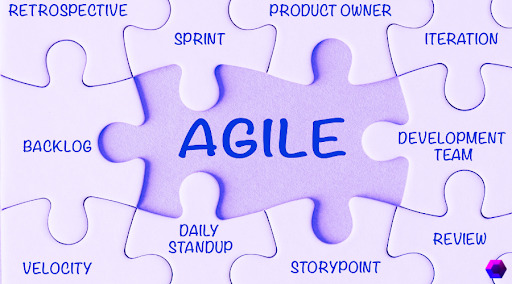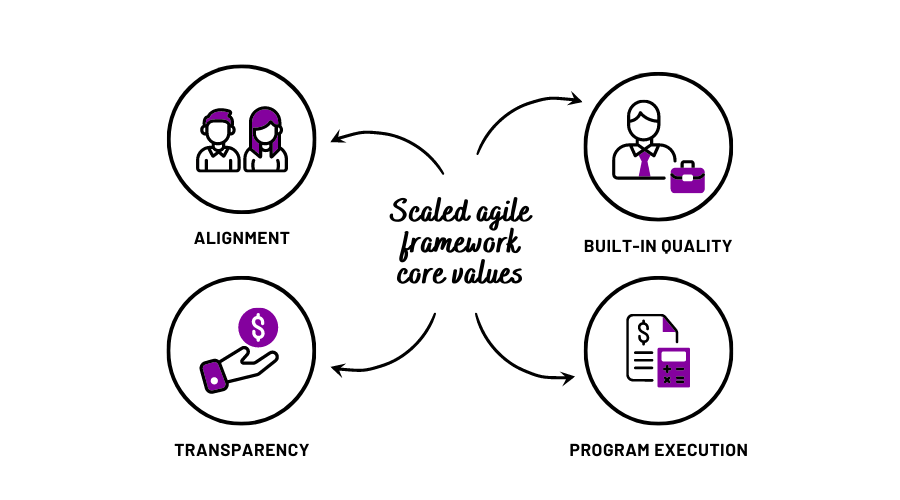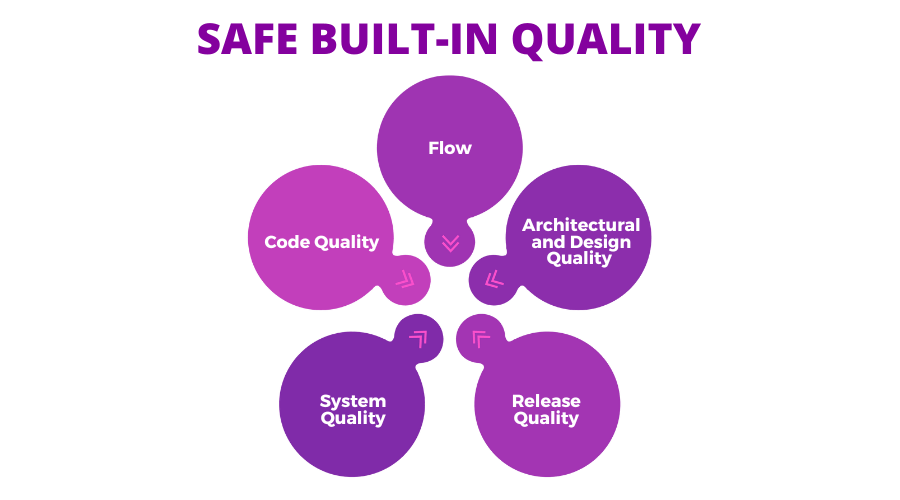
What Are the SAFe Core Values?
Definition of Core Values of SAFe:
SAFe stands for Scaled Agile Framework. The SAFe core values include alignment, built-in quality, transparency, and program execution, and these values form a guideline for Agile development.
Before we get into the SAFe core values, let’s understand what SAFe is.
SAFe stands for Scaled Agile Framework. As the name suggests, it is a framework for scaling agile development in an organization.
Agile development is iterative and incremental, with requirements and solutions evolving through cross-functional collaboration.
It supports a rapid and flexible response to change and advocates a time-framed iterative approach.
It is theoretical and does not prescribe specific practices for a development team to follow.
SAFe is ideal for complicated initiatives involving numerous teams of people at the project, portfolio, and program levels.
It enables larger enterprises to handle projects with greater agility and facilitates faster feedback from various stakeholders worldwide.
The SAFe Core Values
SAFe outlines four core values in its framework. The SAFe core values act as a guideline for enterprises to scale their agile development.
The four SAFe core values are as follows:
- Alignment
- Built-in Quality
- Transparency
- Program Execution

Let’s understand these four SAFe core values in detail before we get into the implementation of SAFe.
Alignment
Alignment means that everyone in the organization understands where they’re heading and how they will get there.
The company has a clear target in mind and is moving purposefully toward it. When an enterprise is misaligned, it is unlikely to achieve its goal, even if it believes it knows where it is heading.
Worse, a company that lacks alignment does not respond well to change.
Multiple teams contribute to a program in any organization to ensure that all team members act as one and are heading in the same direction.
Real team alignment occurs when strategy and product backlogs align with the vision, roadmap, and sprint backlogs.
A product management software like Chisel offers an excellent feature called Team Radar which helps with alignment.
Built-in Quality
Built-in quality implies that every team sees quality as a speed enabler and guarantees that every product increment adheres to the highest quality standards.
Quality is built-in rather than added later.
The idea here is that every feature of the product your company is creating should always represent the best quality standards.
Quality, in other words, should never be an afterthought. Many organizations are OK with simply assessing quality after the product—or the latest product iteration—is complete.
However, that is a very shabby approach. There is no way you can force quality into a finished product.
You must include quality every step of the way.
Try product management tools like Chisel that offer feedback inputs for real-time improvement.

Transparency
Transparency is essential because it strengthens organizations and makes them more resilient.
When things haywire, trust and information transparency facilitate troubleshooting and problem resolution.
Transparency is a necessary component of an operating company. This is because it fosters trusting connections, which results in higher employee satisfaction.
Program Execution
Program execution is the final SAFe core value.
It comes straight from the Agile manifesto, which emphasizes, among other things, that working software is more important than extensive documentation.
Read more about the Agile principles here.
As a result, SAFe prioritizes systems that operate consistently and reliably.
A company can be highly open and aligned, but that will not preserve the organization if it fails to develop consistent value streams.
For this reason, continuous integration, continuous delivery, and continuous deployment play an essential role in Agile.
You don’t just want to deliver value. You want to provide it fast.
Use a top product management software that offers Kanban boards feature to stay on top of your tasks and move efficiently for release.
Now you know the four SAFe core values well. But you’re probably wondering how do you achieve or implement these?
How To Achieve These Core Safe Values?
We’ve taken the first step. We’ve understood the four SAFe core values, and let’s see how we can achieve each of them.
How To Achieve Alignment?
SAFe facilitates alignment through a set of practices.
Strategic decisions begin at the portfolio level and cascade down through the responsibilities of production, solution management, and product owners.
You convey commitments via PI (Product Iteration) objectives and iteration goals, which are critical to structuring the entire firm in the form of an agile release train.
How To Achieve Built-in Quality?
SAFe built-in quality thinking revolves around five hot points:
- Flow
- Code Quality
- Architectural and Design Quality
- System Quality
- Release Quality
These are all linked.
You may achieve flow by using test-first methods and continuous delivery.
Software engineering approaches like pair programming, continuous integration, and coding standards can help SAFe organizations achieve code quality.
Furthermore, the architecture and design quality will help obtain quality code.
Code quality contributes to overall system quality. Having a dependable CI/CD pipeline will also increase release quality, which will help to keep the company in flow and complete the entire cycle.
How To Achieve Transparency?
SAFe delivers transparency via various techniques.
Teams make short-term commitments and then follow through on them. Documents, records, objectives, and progress metrics are available at all organizational levels.
Everyone can see how quickly the teams work, which enhances transparency and trust.
In a nutshell, high visibility is essential.
How To Achieve Program Execution?
Efficient program execution is primarily a result of the other core values, especially built-in quality.
When solid quality methods are in place, it is better to identify, diagnose, and resolve errors before they become critical.
This assures consistent systems and operations.
Some of the best practices for program execution include adopting Scrum. Scrum is one of the most used product manager tools.
Now, you have a clearer picture of how you can adopt the SAFe core values. But why should you?
What Are the Benefits of SAFe Core Values?
There wouldn’t be so much of a buzz around the SAFe core values if they weren’t so beneficial.
Alignment, built-in quality, transparency, and program execution are the four essential values of SAFe. They all work together to align organizations so that they can achieve their objectives.
SAFe is highly useful in large teams since it focuses on business processes and outcomes. Organizations that have implemented SAFe best practices can boast improved staff productivity, engagement, and efficiency.
The core values of SAFe help organizations work efficiently when scaling themselves.
Working at a smaller level with Agile development can be easy. However, as you evolve into a full-blown enterprise, you need some direction.
You can tackle the complexities that come with bigger teams and higher demand. The core SAFe values work as a lighthouse for your prioritization.
Here are some of the critical benefits of the core SAFe values:
- Faster Time-to-Market
- Increased Productivity
- Improved Quality
- Higher Employee Engagement
Let’s break these down for you.
Faster Time-to-Market
Improved time-to-market is one of the advantages of expanding agile with SAFe.
Leading organizations may address customer needs faster by unifying cross-functional agile teams with value.
Implementing SAFe enables businesses to make faster choices, communicate more effectively, automate operations, and remain customer-focused.
Increased Productivity
SAFe enables high-performing teams and Agile release trains to avoid needless work, detect and eliminate delays, and continually improve.
Thus, ensuring that they develop the right things, resulting in measurable productivity gains.
Improved Quality
Built-in quality is a fundamental SAFe value that emphasizes the significance of incorporating quality into all stages of the development cycle.
Scaling Agile with SAFe helps companies by changing quality from a last-minute concern to everyone’s first responsibility.
Higher Employee Engagement
Isn’t this obvious? Employees engage more when working conditions are smooth.
Better working methods result in a happier, more engaged workforce.
Scaling agile with the Scaled Agile Framework has the added benefit of assisting skilled professionals in achieving independence, expertise, and purpose. These are critical variables in unleashing self-motivation.
Organizations that use the core values of the Scaled Agile Framework have the tools they need to reduce burnout and boost employee happiness.
Don’t Believe It? Here Are Some Statistics
Well over 1,000,000 people in 20,000 businesses across the globe have recognized the advantages of growing agile with SAFe.
The following are results from consolidated case studies:
- 10%-50% happier and more motivated employees.
- 30%-75% faster time-to-market.
- 20%-50% increased productivity.
- 25%-75% improvement in quality.
Conclusion
SAFe is a framework for scaling agile development. It has a set of core values that help to reinforce the philosophy behind agile development. This article outlined the four core values of SAFe and explained how they could help your team to be more effective.
The four SAFe core values include alignment, built-in quality, transparency, and program execution. With the SAFe implementation, organizations can achieve various benefits. These benefits include faster time-to-market, improved quality, increased productivity, and employee engagement.
Come back here every time you want to learn how to achieve the SAFe core values.
To start scaling agile development today, sign up for a free trial of Chisel!
